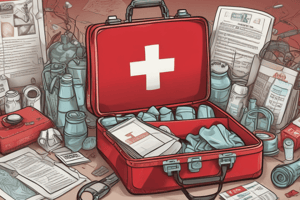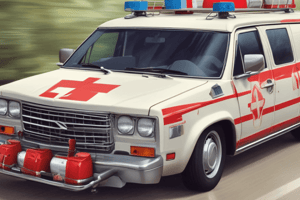Podcast
Questions and Answers
What should you NOT do if there is an object in the eye?
What should you NOT do if there is an object in the eye?
- Blink eyes rapidly
- Remove contact lenses
- Rub it (correct)
- Flush with clean water
What is the first step in treating a bite from a warm-blooded animal?
What is the first step in treating a bite from a warm-blooded animal?
Wash out the wound with soap and water.
What should you do if you have a puncture wound from a fishhook?
What should you do if you have a puncture wound from a fishhook?
Wrap a 3-foot length of fishing line around the bend of the hook and push down on the shank to free the barb.
How should you treat a puncture wound from a nail?
How should you treat a puncture wound from a nail?
What is the recommended action for splinter removal?
What is the recommended action for splinter removal?
What should you do for serious burns?
What should you do for serious burns?
How should you respond to heat exhaustion?
How should you respond to heat exhaustion?
What is the first step in treating shock?
What is the first step in treating shock?
What technique helps someone experiencing hyperventilation?
What technique helps someone experiencing hyperventilation?
What should be done for a person experiencing dehydration?
What should be done for a person experiencing dehydration?
What actions should be taken for heatstroke?
What actions should be taken for heatstroke?
What is the first thing to do when dealing with hypothermia?
What is the first thing to do when dealing with hypothermia?
What is the principle of Leave No Trace?
What is the principle of Leave No Trace?
Flashcards are hidden until you start studying
Study Notes
First Aid for Eye Injuries
- For an object in the eye: do not rub; blink rapidly to wash it out; flush with clean water; pull eyelid to encourage object removal; if unsuccessful, cover with gauze and seek medical attention.
First Aid for Animal Bites
- For bites from warm-blooded animals: wash with soap and water, flush, control bleeding, cover with sterile bandage, and seek medical help promptly.
First Aid for Fishhook Injuries
- For puncture wounds from fishhooks: wrap fishing line around the hook to free it; wash with soap, apply antibiotic ointment, and bandage the area.
First Aid for Nail Puncture Wounds
- For puncture wounds from nails: avoid removing the nail; gently wash with soap and water, apply a sterile bandage, and seek medical attention.
First Aid for Splinters
- For puncture wounds from splinters: use sterilized tweezers to remove splinters; flush with clean running water, apply antibiotic ointment, and cover with a sterile bandage.
First Aid for Second Degree Burns
- For serious burns: assess the situation; move away from heat if safe; treat breathing or severe bleeding emergencies first; cool burns with water or wet cloths, then let dry and cover with sterile gauze.
First Aid for Heat Exhaustion
- For heat exhaustion: have the victim lie in a cool, shaded area; remove excess clothing; cool with wet cloths; if alert, allow them to drink water; seek medical help if symptoms persist.
First Aid for Shock
- For shock: call for help; treat underlying issues like airway problems, severe bleeding, or poisoning; help the person lie down, elevate feet if no spinal injury suspected, and keep warm.
First Aid for Hyperventilation
- For hyperventilation: speak calmly to encourage slow breathing; suggest breathing through the nose while closing one nostril to manage breath rates.
First Aid for Dehydration
- For dehydration: encourage fluid intake; rest in a shaded or air-conditioned area; ensure warmth in cold conditions with dry clothing and shelter.
First Aid for Heatstroke
- For heatstroke: call for emergency help; move the person to a cool area; loosen clothing; cool skin with wet cloths or ice packs; allow small sips of water if conscious.
First Aid for Hypothermia
- For hypothermia: bring the person to shelter; replace wet clothing with dry; wrap in blankets; provide warm liquids if conscious; use warm water bottles on armpits and groin.
Principles of Leave No Trace
- Plan ahead and prepare to minimize impact.
- Travel and camp on durable surfaces to protect the environment.
- Dispose of waste appropriately to prevent pollution.
- Leave natural and cultural features undisturbed.
- Minimize campfire impacts by using existing fire rings or portable stoves.
- Respect wildlife by observing from a distance and not feeding them.
- Be considerate of other visitors to enhance mutual experience.
Studying That Suits You
Use AI to generate personalized quizzes and flashcards to suit your learning preferences.




